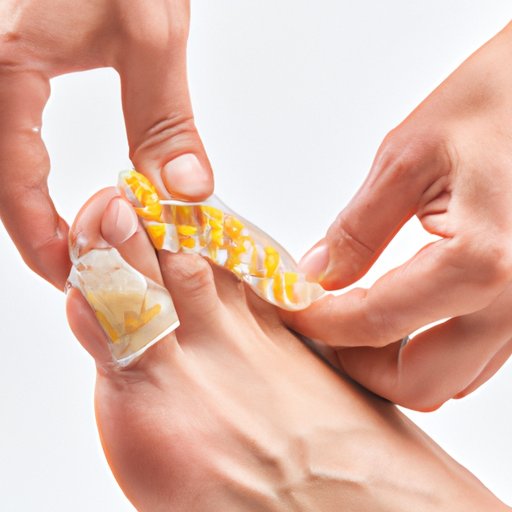
Introduction
Corns can be painful and frustrating, and they can affect your everyday life. Corns often develop on the toes due to constant friction and pressure. Fortunately, there are effective ways to get rid of corns. In this article, we will discuss natural remedies, over-the-counter treatments, professional treatment, proper footwear, toe separators, and lifestyle changes that can help you eliminate corns.
Natural Remedies
Soaking your foot in warm water with Epsom salt or apple cider vinegar is an effective way to soften corns. Epsom salt contains magnesium sulfate that can reduce inflammation and pain. Apple cider vinegar has acetic acid that can break down the thickened skin of corns.
Applying castor oil or crushed garlic directly to the corn can also be helpful. Castor oil can lubricate the skin and make it easier to remove the corn. Garlic has antibacterial and antifungal properties that can reduce the risk of infection.
Other natural remedies that may be effective include using a pumice stone to gently sand away the layers of the corn, applying aloe vera gel to moisturize the skin, and using chamomile tea bags as a poultice to soothe the affected area.
Over-the-Counter Treatments
There are various over-the-counter treatments available at pharmacies and drug stores that can help get rid of corns. These treatments usually contain salicylic acid, which can dissolve the protein that makes up the corn. Some over-the-counter treatments also contain urea, which can soften the corn.
Advantages of over-the-counter treatments include their affordability and accessibility. Disadvantages include the potential for skin irritation, and they may not be effective for severe cases of corns. It is important to follow the instructions carefully when using over-the-counter treatments and to stop using them immediately if they cause any discomfort or pain.
Tips for properly using over-the-counter treatments include choosing the right strength based on the severity of your corn, avoiding using them on healthy skin, and using a pumice stone to remove the dead skin after treatment.
Professional Treatment
If natural remedies and over-the-counter treatments do not work, it may be time to consider seeking professional treatment from a podiatrist. Medical-grade salicylic acid treatment involves applying a higher concentration of salicylic acid directly to the corn. This treatment can be more effective than over-the-counter treatments, but it should only be performed by a medical professional.
Surgical removal of the corn is another option for severe cases. This involves removing the corn and the underlying tissue surgically. While effective, surgical removal can be expensive and may require a longer recovery time than other treatments.
It is important to consider the potential risks associated with professional treatment, such as infection and scarring. It is also essential to assess the cost of treatment and determine if it is covered by insurance.
Proper Footwear
One of the best ways to prevent the development of corns is to wear well-fitting shoes. Shoes that are too tight or too loose can cause friction and pressure on the toes, leading to the formation of corns. Shoes with a wide enough toe box can help prevent the toes from getting squeezed together.
Types of shoes that may help prevent the development of corns include those made of soft and flexible materials that do not constrict the feet, and those with low heels to prevent added pressure on the toes.
Tips for finding shoes with a wide enough toe box include shopping at stores with a wide range of sizes and widths, trying on shoes at the end of the day when your feet are more swollen, and checking for any areas of pressure or discomfort before purchasing.
Toe Separators
Toe separators are designed to help prevent the formation of corns by keeping the toes separated and reducing pressure on certain areas. They can also be used to relieve pain and discomfort caused by existing corns.
Types of toe separators available include those made of gel, foam, and silicone. Gel and foam toe separators are usually disposable and can be worn inside shoes. Silicone toe separators can be reused and are durable.
Tips for using toe separators effectively include choosing the right size based on the width of your toes, wearing them for short periods initially to allow your feet to adjust, and avoiding overusing them, which can cause muscle weakness.
Lifestyle Changes
Making lifestyle changes can be an effective way to prevent the development of corns. Examples of lifestyle changes that may be helpful include maintaining good foot hygiene, wearing socks made of breathable materials, and using cushioned insoles to reduce pressure on the feet.
Other tips for incorporating lifestyle changes into everyday routines include elevating your feet when resting, stretching your feet and toes regularly, and avoiding prolonged periods of standing or walking.
Conclusion
In conclusion, corns can be painful and frustrating, but there are effective ways to get rid of them. Natural remedies, over-the-counter treatments, professional treatment, proper footwear, toe separators, and lifestyle changes can all help prevent and eliminate corns. It is important to assess the severity of your corn and choose the most appropriate treatment. If natural remedies and over-the-counter treatments are not effective, it may be time to consider seeking professional treatment from a podiatrist. Don’t let corns compromise your comfort and quality of life.




